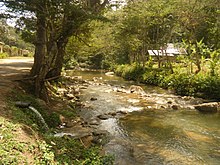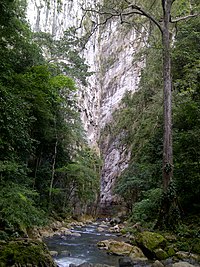Monagas
Although settlement of the territory was slow, archaeological excavations and observations by the chroniclers of the Indies point to the existence of a well-developed village in Barrancas in 1530, when the conquistador Diego de Ordaz passed through the area in search of El Dorado.Also in the 16th century, missionaries arrived in the highlands and slowly the Christianisation and re-education of the Indians spread to the south; they thus adapted to a more sedentary life.In the site where Barrancas is located today, archaeological objects and utensils have been found that belonged to the so-called Barrancoid and Saladoid cultures, the oldest of which have been dated to 1000 years before the Christian era.Diego de Ordaz, a Spanish explorer obsessed with finding the legendary site of El Dorado, arrived in the village in August 1531 after traveling up the Orinoco River via the Caño Manamo.Impressed by its number of inhabitants – which he estimated at "more than 400 bohíos" ('huts') – he decided to go down and meet personally with the cacique Naricagua, lord of his territories, whose name of the river Uyapari was associated with the village.In 1799 the German geographer Alexander von Humboldt and the Frenchman Aimé Bonpland visited Caripe as part of their trip through Venezuela.During the 16th and 17th centuries, the people of the plains and swamps north of the Orinoco, under the rule of the Caribs, made alliances with the French and Dutch as a policy of tenacious resistance against Spanish domination.1 well in the Quiriquire field in 1928, oil exploitation began and the area experienced an important boost in urban development due to the arrival of migrant labor, particularly from the Caribbean Islands.In 1936 Caripito International Airport was selected by aviator Amelia Earhart and her navigator Fred Noonan as the second stopover of their trip around the world, staying overnight at the Standard Oil Company facilities.The event was widely publicized in the international press and the company provided logistical support to continue the flight through South America.Under the direction of the Corporación Venezolana de Guayana, several hectares of Caribbean pine were planted between Barrancas and the nearby town of Uverito, an activity that significantly boosted the development of the area.By the 1970s, it was the most important settlement[citation needed] and port in the state of Monagas, mainly due to the lack of land road connections to the main nearby cities, such as Tucupita (Delta Amacuro) and Puerto Ordaz (State of Bolivar), although today it continues to be an important center for the transport of goods and passengers to these cities.In the northeast and the southeast there are deltaic savannas in which rivers such as the San Juan, Guanipa, Caño Mánamo, and Tigre flow into.The region is dominated by a rainy tropical climate with some local variations that respond to various factors such as altitude, wind and proximity to the sea.Most of the state, in the southern strip, has a climate typical of savannas with dry seasons that can last up to six months, which produces a severe water shortage.On the other hand, the Guarapiche, San Juan, Río de Oro, and Caripe rivers flow into the Atlantic Ocean.The dominant vegetation type in the north of Monagas State is rainforest, such as that found in the mountainous area of the San Juan River valley and the municipalities of Acosta and Caripe.Another variation of the vegetation present in Monagas State can be found along the banks of the main rivers, where extensive forests of mangroves, palms and morichals have formed.It consists of dancing with a temblador (a fish, the electric eel, found in the rivers closest to the town) made of cardboard and cloth.[6] On 2 December 2015, Venezuelan curagua fiber and weaving was declared an Intangible Cultural Heritage of Humanity by UNESCO at its annual meeting in Windhoek, the capital of Namibia.Once it is salcochada[clarification needed] and spun, this fiber is tied to special sticks and woven between them, giving it the shape of a sheet; when loops are made at the ends, it takes the form of a hammock.During Holy Week, cuajado de morrocoy (a dish made from red-footed tortoise) is common due to the belief that it is profane to eat meat at this time.Also during Holy Week, cuajado de cazon made from the school shark is common in the area of the eastern coast.The predominant religion in the state is Christianity.Catholicism is the Christian branch which has the largest number of followers, as a consequence of the evangelization carried out by Catholic missionaries, such as the Franciscans, in the 17th and 18th centuries.Under and between the lower part of the rifles, there is a red and black ribbon, representative of the war to the death, and in it a broken key symbolizing that its capital was forced, but never surrendered.

























Monagas (disambiguation)State of VenezuelaCoat of armsHimno del Estado MonagasVenezuelaMaturínLegislative CouncilGovernorAssembly delegationTime zoneUTC−4ISO 3166 codeEmblematic treeSpanishstatesSucre StateAnzoátegui StateBolívar StateDelta Amacuro StateParia GulfJosé Tadeo MonagasJosé Gregorio MonagasKalinaOrinoco DeltaconquistadorDiego de OrdazEl DoradoChristianisationBarrancoidSaladoidCaño ManamocaciqueJuan de CastellanosElegías de varones ilustres de IndiasCapuchinCaicara de MaturínCaripeAguasayAlexander von HumboldtAimé BonplandAgostino CodazziFerdinand BellermannCumanáStandard Oil CompanyCaripitoPan American AirwaysAmelia EarhartFred NoonanPunta de MataPunceresCorporación Venezolana de GuayanaTucupitaDelta AmacuroPuerto OrdazState of BolivarnationalizedRepsolXanthosomaLibertador MunicipalitydeltaicSan JuanGuanipaCaño MánamomassifsCretaceousLlanosMorichal LargoGuarapicheAnzoategui StatehydrographicAraguamoricheCaribbean pinejabillocarob treeCueva del Guácharo National ParkRibero MunicipalityList of Venezuela state legislaturesList of Venezuela state constitutionsList of Venezuela governorsNational PoliceVenezuelan National GuardGovernor of MonagasAcción DemocráticaMovimiento Quinta RepúblicaJosé Gregorio BriceñoMIGATOUnited Socialist Party of VenezuelaAcostaBolívarCedeñoEzequiel ZamoraLibertadorAragua de MaturínSanta BárbaraSotilloBarrancas del OrinocoUracoaInstituto Nacional de EstadísticaMestizoNueva EspartaRomanesqueWilliam H. Phelps SrBaharequeUniversidad de OrienteUniversidad Bolivariana de VenezuelaUniversidad Pedagógica Experimenta LibertadorUniversidad Nacional Experimental Simón RodríguezUniversidad Santa Maríagalerónjoropoliqui liquiSimon the ZealoteffigyChilean blue crocuselectric eelcuatroIntangible Cultural Heritage of HumanityUNESCOMucunaJob's tearscachapacasabeempanadamondongoqueso de mano